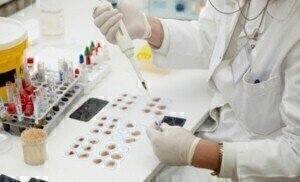News
Diagnostic Ultrasonics on the Nanoscale
Oct 06 2010
Scientists and Engineers at The University of Nottingham have built ultrasonic transducers capable of generating and detecting ultrasound that are orders of magnitude smaller than current systems — so tiny that up to 500 of the smallest ones could be placed across the width of one human hair. While at an early stage these devices offer a myriad of possibilities for imaging and measuring – such as potential to be placed inside cells to perform intracellular ultrasonics. Able to produce ultrasound of such a high frequency that its wavelength is smaller than that of visible light, theoretically they make it possible for ultrasonic images to take finer pictures than the most powerful optical microscopes.
The work, by the Applied Optics Group in the Division of Electrical Systems and Optics, has been deemed so potentially innovative that last year it was awarded a £850,000 five year Platform Grant by the Engineering and Physical Sciences Research Council (EPSRC) to develop advanced ultrasonic techniques. The team has also been supported by additional funding of £350,000 from an EPSRC grant to underpin aerospace research.
Matt Clark, of the Applied Optics Group, said: “With the rise of nanotechnology you need more powerful diagnostic tools, especially ones that can operate non-destructively and ones which can be used to access the mechanical and chemical properties of the samples at this scale. These new transducers are hugely exciting and bring the power of ultrasonics to the nanoscale.”
The transducers sandwich or shell like structures possess both optical and ultrasonic resonances; a pulse of laser light will set these ringing at high frequency which launches ultrasonic waves into the sample. When they are excited by ultrasound the transducers are very slightly deformed and this changes their optical resonances which are detected by a laser. As ultrasonics is used in medical imaging, engineering applications and for chemical sensing, these tiny transducers open up the possibility of using these techniques not only inside cells but also on nanoengineered components.
Dr Clark said: “Imagine imaging inside cells in the same way that ultrasonic imaging is performed inside bodies. Theoretically we could get higher resolution with the nano-ultrasonics than you can with optical microscopes and the contrast would be very interesting. In addition the transducers can be made into highly sensitive chemical sensors; this would allow you to distribute chemical sensors in tissue or in paint — so you could make paint with chemical sensors to detect corrosion or explosives in it.” The research was performed between the Division of Electrical Systems and Optics in the Faculty of Engineering and the School of Pharmacy.
Digital Edition
Lab Asia Dec 2025
December 2025
Chromatography Articles- Cutting-edge sample preparation tools help laboratories to stay ahead of the curveMass Spectrometry & Spectroscopy Articles- Unlocking the complexity of metabolomics: Pushi...
View all digital editions
Events
Jan 21 2026 Tokyo, Japan
Jan 28 2026 Tokyo, Japan
Jan 29 2026 New Delhi, India
Feb 07 2026 Boston, MA, USA
Asia Pharma Expo/Asia Lab Expo
Feb 12 2026 Dhaka, Bangladesh



















